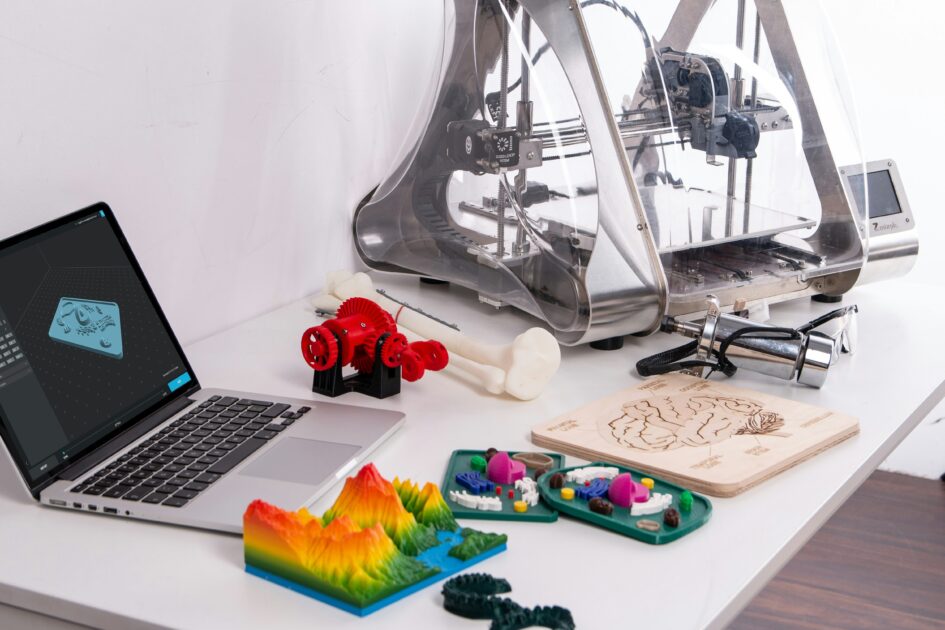3D printing technology may no longer be considered a new invention, but its potential for growth and impact across various industries is still expanding rapidly. This technology constructs objects layer by layer from a digital model, employing a diverse array of materials, including plastics, metals, ceramics, and even living cells! Its applications are just as vast and varied. Let us look at the various ways 3D printing technology has been put to work in different fields.
Aerospace: Driving Efficiency and Innovation
The aerospace industry values 3D printing for its ability to produce parts that are both lighter and stronger than those made through traditional manufacturing. This is crucial for an industry where every gram counts, as lighter aircraft are more fuel-efficient and have a lower environmental impact. Moreover, complex parts that were once prohibitively expensive to manufacture are now feasible. This includes everything from small, intricate components like fuel nozzles with internal geometries optimized for better performance to large structural elements that reduce the number of parts needed in assembly.
At the same time, the aerospace industry is exploring more than just component manufacturing. NASA and private space companies are investigating the potential of using 3D printing to build habitats on other planets using local materials, significantly reducing the need to transport materials from Earth. The ability to print replacement parts or tools on-demand in space or on other celestial bodies could dramatically reduce the logistics and costs associated with space missions as well. While this all seems like sci-fi, it is quickly becoming a reality with the advancements in 3D printing technology.
Entertainment: Customized Fun and Enjoyment
From the bedroom to the big screen, 3D printing is enabling the creation of personalized and unique products. For instance, 3D printed adult toys are gaining popularity for their ability to be customized to individual preferences, sizes, and shapes—and can even be made to mirror the attributes of a special someone. Outside the bedroom, toys such as action figures, board game pieces, and puzzles can be 3D printed, empowering consumers and turning them into creators in their own right. For toy manufacturers, 3D printing offers a way to efficiently produce small runs of specialized toys, catering to niche markets.
On a larger scale, filmmakers are utilizing 3D printing to create intricate props, costumes, and set pieces with a level of detail and customization that was previously difficult to achieve. When time is of the essence this method of manufacturing is key to delivering what you need to meet almost any deadline. From Victorian-era jewelry to futuristic sci-fi weapons, 3D printing allows filmmakers and costume designers to bring their visions to life. Instead of having to rely on traditional manufacturing methods or outsourcing to specialized workshops, it is now possible to create these items in-house, saving time and cost in the production process. The economies of scale also no longer apply here, making one-of-a-kind reproductions more affordable. If you don’t already have a 3D modeller employed at your company now would be a very good time to look into making that a priority.
Healthcare: Revolutionizing Treatment and Research
3D printing technology is transforming healthcare, offering innovative solutions that were unimaginable just a few decades ago. It allows for the creation of custom-fit prosthetics and implants, dramatically improving patient outcomes and comfort. Unlike traditional manufacturing methods, 3D printing can produce devices that perfectly match the patient’s anatomy, reducing the risk of rejection and the need for revision surgeries. This customization extends to dental work as well, where 3D printing can create precise dental implants and orthodontic devices quickly and efficiently.
Furthermore, bioprinting opens up groundbreaking possibilities, such as printing skin for burn victims, cartilage for joint repair, and even organs for transplantation. This aspect of 3D printing may eventually help to overcome the current limitations posed by donor organ shortages. Additionally, researchers are using 3D printing to create detailed anatomical models for surgical planning and training. These models allow surgeons to practice and plan complex surgeries in a risk-free environment, significantly improving their chances of success when performing actual surgeries. Combining the use of 3D printing and VR technologies is surely a matter of time to further progress the options available to professionals in this field.
Education: A Tool for Learning and Research
3D printing is helping to bridge the gap between theoretical knowledge and practical application. In educational settings, it offers students a hands-on learning experience by bringing abstract concepts to life. This enhances the understanding of complex concepts, particularly in STEM (Science, Technology, Engineering, and Mathematics) subjects. Furthermore, the technology provides an accessible platform for teachers to create custom educational materials, such as tactile teaching aids for visually impaired students or complex geometric shapes that are otherwise difficult to visualize and understand.
When it comes to research, 3D printing is a similarly useful tool for discovery and understanding. Scientists and researchers utilize the technology to create detailed models for a variety of purposes, from visualizing microscopic biological structures to replicating archaeological artifacts for study. Using these models, they can conduct experiments and learn more about the properties and behaviors of various materials without risking damage to the original objects. In engineering and material sciences, 3D printing allows for rapid prototyping, enabling researchers to test and refine their designs in real time.
Conclusion
3D printing technology is driving a global shift towards more personalized, efficient, and sustainable manufacturing. Its creations, from bespoke personal enjoyment devices to lightweight aerospace components, illustrate its potential to impact virtually every facet of our lives. With ongoing advancements in materials science, digital design, and printing processes, the future of 3D printing is incredibly bright and exciting. What do you think we will be able to print next?
